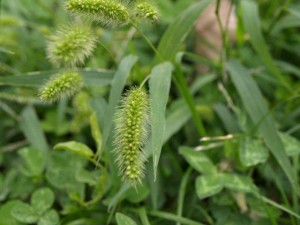The Donald Danforth Plant Science Center in St. Louis has received a $12.1 million grant from the U.S. Department of Energy to develop a more drought-resistant type of grass that can be processed into biofuels. The five-year award will be shared by collaborators at Carnegie Institution for Science, University of Illinois in Urbana-Champaign, University of Minnesota, and Washington State University.
The project will develop a new model plant system based on the grass species Setaria viridis (pictured right). To engineer bioenergy grasses with the desirable traits needed for large scale production, researchers need model plant systems that are closely related to bioenergy feedstocks, but which are more amenable to genetic analysis. According to the Danforth Center, Setaria viridis (S. viridis) fills that bill.
This year, extreme heat and lack of rainfall combined with a mild winter has resulted in an all-time low in soil moisture and challenges for growers of food and biofuel crops alike. Even under normal conditions, drought is the leading stress crops endure, and is of increasing concern due to diminishing water supplies worldwide and climate change.
Bioenergy grasses can provide a sustainable source of renewable fuels, which unlike row crops like corn, can be grown on marginal lands and do not require annual planting or the addition of chemical fertilizers. However, these grasses still need water, and the project aims to engineer a new generation of bioenergy crops with greater drought resistance and other properties that will make them more productive.
Thomas Brutnell, who heads the Danforth Center’s renewable fuels institute, will be the project’s principal investigator. Brutnell and colleagues will apply genomic, computational, and engineering tools to dissect the genetics of drought and density response in S. viridis. The research team is expected to produce an extensive molecular description of plant growth, generating several million data points for collection from physiological and molecular genetic studies.
From the investigation, Brutnell’s team aims to discover the molecular mechanisms that underlie drought responses and identify candidate genes and pathways for improving the closely related feedstock grasses. But the project is also expected to have benefits for the productivity of cereal crops. S. viridis, Brutnell notes, “is closely related to corn and Brachypodium, another model grass of interest at the Danforth Center that has a genetic makeup similar to wheat.”
Read more:
- International Consortium Studies Corn Genome
- Bayer, Texas AgrilLife to Partner on New Wheat Varieties
- NYU to Study Response of Rice to Environmental Change
- USDA, Energy Fund Research to Accelerate Biofuel Crops
* * *


 RSS - Posts
RSS - Posts
[…] Grant to Fund New Drought-Resistant Biofuel Grasses […]
I won’t get into the whole “is it or is it not man-made” argument of global warming. But regardless of one’s belief on that, it seems quite evident that things are warming up a bit. Any research/experimentation with drought-resistant plants, whether to be used for food or biofuels, certainly seems like a good and worthwhile move.
Thanks John for your comment and readership of Science Business. The arguments for engineering drought resistance into new strains of prairie grasses indeed go well beyond climate change: energy security, food security, and economic returns. – AK
[…] Grant to Fund New Drought-Resistant Biofuel Grasses […]